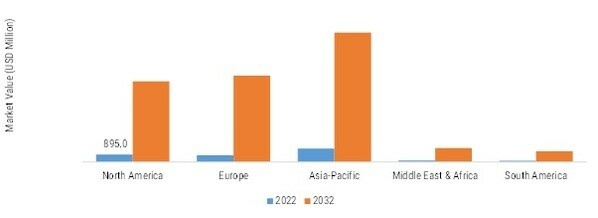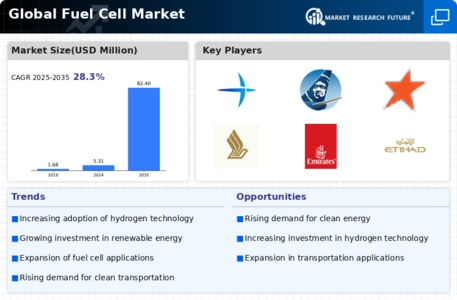By Region, the study provides market insights into North America, Europe, Asia-Pacific, Middle East & Africa, and South America. In terms of revenue, North America held the largest share of 37.7% in the Fuel Cell market in 2022 and is expected to maintain its dominance during the forecast period. Asia Pacific is the largest market for Fuel Cell. Because it has more financial institutions than any other, the region has attracted international investors. Local players dominate the market, resulting in severe entry hurdles.
The Asia-Pacific region continues to be a significant market for fuel cells, driven by supportive policies from countries like Japan, South Korea, China, and others. Japan has been at the forefront of developing the hydrogen economy and fuel cell technologies. It aims to commercialize fuel cell vehicles and build out hydrogen refueling infrastructure. South Korea is also a leader, with major companies like Hyundai developing and deploying fuel cell buses and vehicles. Japan is collaborating with Indonesia and Vietnam to build hydrogen ecosystems through projects like setting up hydrogen refuelling stations and fuel cell power plants.
This will help expand infrastructure and markets. China has ambitious targets for fuel cell vehicles and increasing hydrogen production. It invests heavily in growing its domestic industry and deploying fuel cell technologies. South Korean shipbuilding company Korea Shipbuilding & Offshore Engineering has invested in fuel cell company Elcogen to strengthen collaboration on marine and stationary fuel cells. This will help expand the manufacturing and commercialization of Elcogen's solid oxide fuel cell technology.
The Asia-Pacific fuel cell market is expected to see strong continued growth in the coming years as significant countries work to transition to cleaner energy technologies and build domestic fuel cell industries. Government policies and investments from private companies and countries create opportunities for the market to expand.
Figure3: Fuel Cell Market Size By Region 2022 & 2032

Source: Secondary Research, Primary Research, Market Research Future Database, and Analyst Review
Further, the major countries studied in the market report are the U.S., Canada, Germany, France, the UK, Italy, Spain, China, Japan, India, Australia, South Korea, and Brazil.
The North American fuel cell market is witnessing growth, the demand is high and continuously surging. In the realm of growing electric vehicle demand and sales, for instance, according to the data from, the International Energy Agency (IEA), in 2022, electric car sales in the United States surged by 55%, outpacing the global average, with Battery Electric Vehicles (BEVs) leading the way, experiencing a 70% increase and reaching nearly 800,000 units.
This marks the second consecutive year of robust growth following a dip in 2019-2020. Despite an 8% decline in total car sales, the U.S. contributed 10% to global sales growth. The total stock of electric cars globally reached 3 million, a 40% increase from 2021, constituting 10% of the global total. Increased model availability, government incentives, and growing awareness contributed to this growth. Further, the government is also investing heavily in the growth of electric vehicle adoption and creating growth opportunities for the global market players to exploit the regional demand.
Europe remains at the forefront when it comes to sustainable development and the automotive industry. With the well-established automotive sector across the region, the demand for the fuel cell especially from the surging automotive industry is driving the fuel cell market growth across the region. Seeking this as an opportunity market players such as Bosch, and others are investing and collaborating to produce fuel cell or hydrogen-based vehicles to curb the demand pool and gain a competitive edge in the market.
For instance, German auto supplier Bosch is set to invest nearly 2.7 billion USD in hydrogen fuel cell technology between 2021 and 2026, anticipating around 5.4 billion USD in sales by 2030. This investment, 1.1 billion USD more than its previous plan, reflects Bosch's commitment to growing with hydrogen. The company foresees one in five new trucks over six metric tons featuring fuel-cell powertrains by 2030. Bosch has commenced production of its fuel cell power module, primarily for commercial long-distance applications, at its plants in Stuttgart-Feuerbach, Germany, and Chongqing, China.
With the growing global interest in electric vehicles and fuel cells to achieve zero-emission by 2050 or 2060 respective to the industry, the Middle East & African region is not left behind. The Middle East, a major oil and gas producer, is embracing hydrogen as part of its economic diversification efforts. While other regions are considering a shift away from fossil fuels, the Middle East aims to maintain its position as a key energy player. Countries like Saudi Arabia, the UAE, and Oman are investing in large-scale hydrogen projects.
Hydrogen, produced from fossil fuels, is well-established in the region, but there is growing interest in blue and green hydrogen. The Middle East's advantage lies in its low-cost hydrocarbon reserves and abundant renewable energy resources.
Further, governments around the region Middle East and Africa are investing and collaborating in electric vehicles and fuel cells. Further, as the region offers immense growth potential for electric vehicles and fuel cells market players operating in such domains are expanding their across these countries to gain high profit margins and curb the demand pool to withstand the global competition.












